This invasion of Poland definitely did not work for Emperor Henry II. When he fled in the last days of August 1015, leaving his army in a hostile land, he had a feeling that it might be wrong with her. He didn't think she was going to be literally wiped off the surface though.
The hostility between the German king and the Polish prince had been building for thirteen years. It all started in 1002 in Merseburg. There was an attempted assassination attempt on the life of Bolesław the Brave, for which he blamed Henry II. Whether it is right, it is not known. In any case, from that moment on, the warriors of both rulers killed each other, seized towns and subjects.
The conflict, though interrupted by peace, truce and oaths, seemed to be endless. The German knights were successful, but were unable to step on the "and". They took the Czech Republic and Meissen from Piast, they even managed to get to Poznań, but they were not able to smoke him out of Lusatia, Milsk and Moravia.
In 1013, there was hope that the protracted war was coming to an end. The feuding rulers made peace in Merseburg. The German monarch was then getting ready to go to Rome, where he intended to decorate his temple with an imperial crown. Poland was in a hurry to invade Ruthenia, because the local prince Włodzimierz imprisoned his daughter. However, the apparent idyll lasted only a few months…
So war!
In 1013 or 1014, Bolesław, who had already had a taste for the rule over Bohemia, tried to regain power over the homeland of Švejk. His cousin Ołdrzych ruled there, loyal to Henry II. The Polish prince, an experienced schemer, first resorted to deception. He wanted to maneuver a relative into an anti-royal conspiracy and then throw him out of Prague ... with German hands! To this end, he sent his favorite son, Mieszko Lambert, to talks.
Unfortunately, Ołdrzych realized what it was and imprisoned Mieszko. Upon hearing of this, the German king demanded the release of the prisoner, which the Prague subject reluctantly did. And then the vindictive and vengeful monarch made a mistake. Instead of sending the hostage back to his father, as wiser advisers had suggested, he kept him locked up. Only after some time did he hand it over to a group of magnates, who vouched for the young prince and sent him to Chrobry. This one, however, was already gasping for revenge.
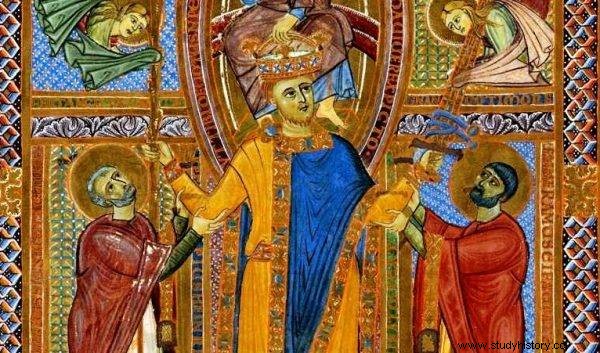
The conflict between Henry II, who was crowned emperor in 1014, and Boleslaw the Brave lasted from 1002.
Piast's hostility was evident at every step. When Henry ordered him to send knights on an Italian expedition, he refused. When, after returning to the Reich, already as emperor, summoned him to his presence, he refused. When he ordered him to return Łużyce and Milsko, he refused. Anyway what he refused! He threatened to invade the Reich!
It was clear that the war was only a matter of time. The German ruler prepared for it with extreme care. In the summer of 1015, four armies set out against Poland. The first was led by the emperor himself, the second was led by the Saxon prince Bernard II, the third by the Czech prince of Ołdrzych, and the fourth by the Austrian margrave Henryk the Strong. The first and the second came from the west to meet, as planned, somewhere between the Odra River and Poznań. The third and fourth were tasked with attacking from the south.
Read also : The Battle of the Bug 1018. How did Bolesław the Brave win the legendary battle, thanks to which he took Kyiv?
Have a nice bad start
Bolesław gave the order to slow down the invaders' march, but the efforts of the princely warriors did not help much. The emperor's army advanced. She crossed the swamps on the Spree and headed towards Krosno nad Odra, about 83 kilometers east of Lubin. As early as August 3, 1015, the Germans crossed the Oder, probably using some unguarded ford, and then literally wiped out a detachment of Poles led by Mieszko that was defending the passage.
The chronicler Thietmar, relying on eyewitness accounts, reports that only three knights were killed on the imperial side. Meanwhile, "the number of those killed on the enemy's side was not less than six hundred." After this victory, the road to Poznań was open. We just had to wait for the armies of Bernard, Ołdrzych and Henryk the Strong ...
Unfortunately, neither of them came. Soon after the victory near Krosno Odrzańskie, envoys from the army of Ołdrzych and Henryk the Strong appeared before the emperor. It turned out that in the meantime, Brave's Moravian warriors made a foray into Austria. Although Henryk Mocny chased them and won the bloody battle, there was no chance that he would reach Wielkopolska with his men on time. In turn, the Ołdrzych conquered Bieżuniec and - as the invaluable Thietmar writes - "took at least a thousand men captive there, not counting women and children, and after burning it, he returned to himself as the winner."
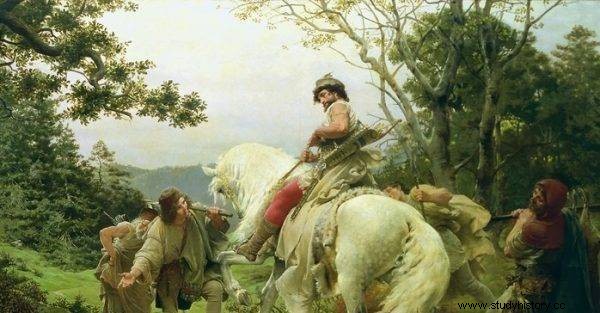
The ogre, one of the feudal lords who was to support Henry in the fight against Bolesław, never joined the emperor.
It was not the end of disappointments for the emperor. Soon the footmen of the Saxon prince Bernard II reached his camp. He reported that after passing Bolesław, who was defending the crossing on the river, he managed to set fire to several towns. But later ... and he decided he wouldn't be able to join the imperial army, so he went home!
This was how Henryk's hopes for the march to Poznań were dashed. With a small number of knights with him, and without the support of the feudal lords, he could only dream about it. All that was left for him was to order a retreat and do everything possible not to run into Polish warriors.
In the country of Dziadoszan
Many expected the emperor to retreat the same way he came. This is what Chrobry himself thought first of all. His opponent, however, sprang to the south cleverly. He crossed the river probably near the town of Cigacice (today's Zielona Góra poviat) and found himself with his army on the land of the Dziadoszan (Dziadoszyców) tribe.
These areas belonged to the Piast monarchy probably from the times of Mieszko I, the Brave father. In practice, this meant, first of all, the obligation to pay tributes and to host the prince and his entourage at his own expense. And, of course, to prosecute an enemy who is leaving the country.
This last task was approached differently, but this time Dziadoszanie were ready to dutifully fulfill their obligations. Five years earlier, in 1010, during one of the previous expeditions against the Polish ruler, their lands were severely ravaged by the army of Henry II. The desire for revenge this time turned out to be stronger than fear.
The German army set up a camp in complete desolation, but the Polish scouts managed to locate it. In order to gain time, Chrobry sent Abbot Tuni, his trusted advisor there. The monk officially made peace proposals. Of course it was a bluff. When Tuni negotiated with the emperor, the warriors of Piast rushed towards the camp, and the prince's emissaries summoned Dziadoszan to come armed and fulfill their duty to fight the enemy.
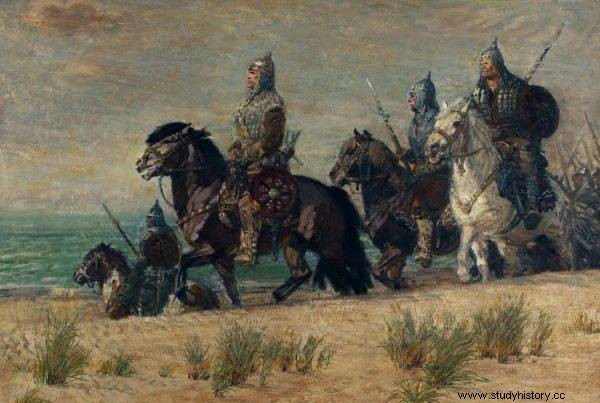
Chrobry's team chased Henry II's army. The illustration shows a painting by Michał Bylina entitled "Team of Bolesławów".
The monarch, however, knew his enemy well and knew the trick right away . He knew the battle was a matter of days, maybe even hours. He stopped Tuni by force, waiting for the troops to cross the swamps, taking advantage of the hastily broken bridges. He only released him when the imperial men felt the ground under their feet.
The ruler of the Reich wanted at all costs to avoid a trial on a hostile land, with a more numerous opponent. Unfortunately, the march of his army seemed to go on forever. Narrow forest roads made it stretch into the shape of a long snake. The march was also delayed by the necessity to pave the roads for the carts on which the equipment, provisions and loot, obtained in the battle near Krosno Odrzańskie, were carried.
Finally, Henryk could not stand it. He separated a troop of mounted knights and went on ahead, leaving his army . At its head he left the Archbishop of Magdeburg Geron, Margrave Geron and Saxon palatine Burchard. Before departing, he advised them to take more than usual precautions. The sad irony is that at least the first two opposed the war with Brave before.
Warriors hidden in the forest
In the early Middle Ages, the Slavs generally avoided open battles. They looked for a chance to win in the forest thickets. Until now, Bolesław used the same strategy. In the conflict lasting from 1003, he never once dared to lead all his forces against the enemy and face a major battle. He preferred to go back, hide in towns, engage in "pull war".
However, in August 1015, the Polish ruler saw his chance. If he was ever going to destroy an imperial army, right now! He prepared an ambush from which no German should come out alive.
The Polish prince took advantage of the fact that the troops led by both Gerons and Burchard were following the usual path cut in the forest. His men settled on either side of her. His teammates were there, among others, the best of the best, dear to maintain, but worth the price. They were armed with expensive, though not very long chopping swords, dressed in Western design in iron-studded leather jackets, with conical helmets on their heads.
Most of Chrobry's units were Dziadosz from the mass movement. In their hands appeared axes, spears, bows, slings and even clubs. They were protected by wooden shields covered with leather. They knew the surrounding forests very well.
Read also : Czech hecatomb of the Piasts
"... they scattered everyone and killed them one by one ..."
The decisive meeting took place on September 1, 1015. This is how the Polish-German clash was described by the chronicler Thietmar:
After a while, enemies hidden in a nearby forest raised a triple shout and then rushed to our army with archers who came running in confusion. Our brave ones resisted the first and second attacks and killed many of the oncoming ones. But the enemies, cheered at the sight of some of our men fleeing, clashed and struck again, scattering them all, and killed them one by one with the help of treacherous arrows.
In feudal Europe, it usually paid off to take a knight prisoner to get a high ransom, not to kill. However, Dziadoszanie, remembering the events from five years ago, about burnt houses, killed relatives, raped mothers, wives and daughters, had no mercy.
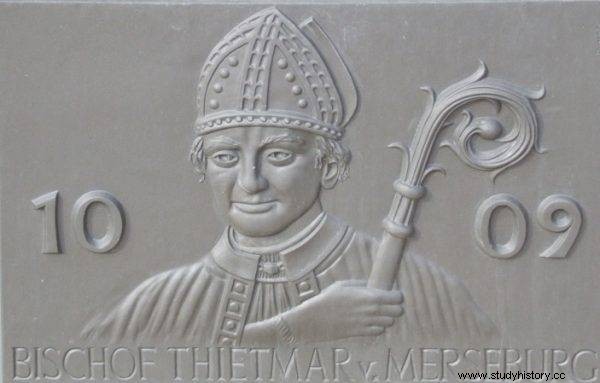
We owe a detailed description of the battle to the chronicler Thietmar.
In the battle died, as noted by Thietmar, "two hundred most venerable knights, whose names and souls may God almighty remember in His mercy!" . Margrave Gero, reluctant to war, was also killed. His death was mentioned in the "Annals of Quedlinburg", an extremely valuable chronicle from that period. The trace of the battle was found even in distant Weissenburg in north-eastern France. In the Benedictine monastery it was written:"Udo komes was killed along with the others."
Only a handful of Germans were captured. Maybe it was some more significant Polish commander who had an idea of this? Few managed to escape, rushing into the unknown, carving their way with swords and shielding themselves from poisoned arrows. The escapees included Archbishop Gero and the wounded Palatine Burchard.
First big win
A handful of survivors of the slaughter, along with the two surviving commanders, managed to catch up with the troop of Emperor Henry II. At the news of the defeat, the ruler of the Reich wanted to go to the battlefield, but he was visited by this idea. Only the Bishop of Meissen, Idzi, was sent there with a small guard.
The Poles, seeing the approaching unit, hid in the forests. When they noticed that it was only a few people with a clergyman in rags (the Giles, unlike other church hierarchs, did not care for the goods of this world), they let them pass without any problems. Bishop with the consent of Brave, buried the fallen, and then drove west with the body of margrave Geron .
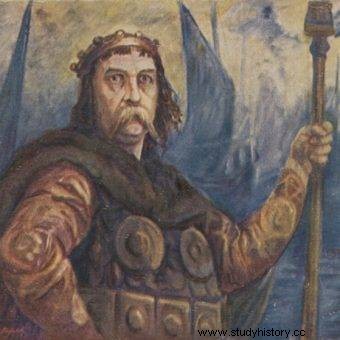
The battle on the land of Dziadoszan ended with a complete defeat of the imperial army.
The battle fought on September 1, 1015 on the land of Dziadoszyce was the first Polish victory over the imperial army. However, it did not end the hostilities. Although Emperor Henry II safely reached the Reich, Mieszko Lambert soon followed in his footsteps. He crossed the Elbe and began the siege of Meissen. It didn't take long. At the sight of the rising river, the young prince rolled them up the very next day. He didn't want to stay cut off in hostile territory.
In 1017, Emperor Henry II invaded Poland again, but this time his army got stuck under the heroically defending Germany. Finally, in January 1018, peace was made in Bautzen. It was sealed with the marriage of 51-year-old Bolesław the Brave with the young Oda, the youngest sister of margrave Geron. The same one who died in the land of Dziadoszan.
Read also:Did the warriors of Bolesław the Brave take part in the invasion of England?
